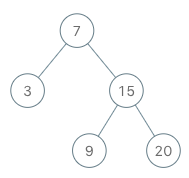力扣——二叉搜索树迭代器
作者:互联网
实现一个二叉搜索树迭代器。你将使用二叉搜索树的根节点初始化迭代器。
调用 next() 将返回二叉搜索树中的下一个最小的数。
示例:

BSTIterator iterator = new BSTIterator(root); iterator.next(); // 返回 3 iterator.next(); // 返回 7 iterator.hasNext(); // 返回 true iterator.next(); // 返回 9 iterator.hasNext(); // 返回 true iterator.next(); // 返回 15 iterator.hasNext(); // 返回 true iterator.next(); // 返回 20 iterator.hasNext(); // 返回 false
提示:
next()和hasNext()操作的时间复杂度是 O(1),并使用 O(h) 内存,其中 h 是树的高度。- 你可以假设
next()调用总是有效的,也就是说,当调用next()时,BST 中至少存在一个下一个最小的数
/**
* Definition for a binary tree node.
* public class TreeNode {
* int val;
* TreeNode left;
* TreeNode right;
* TreeNode(int x) { val = x; }
* }
*/
class BSTIterator {
LinkedList<Integer>list=new LinkedList<>();
public BSTIterator(TreeNode root) {
inOrder(root);
}
void inOrder(TreeNode p) {
if(p!=null) {
inOrder(p.left);
list.add(p.val);
inOrder(p.right);
}
}
/** @return the next smallest number */
public int next() {
if(hasNext())
return (int)list.pollFirst();
return -1;
}
/** @return whether we have a next smallest number */
public boolean hasNext() {
if(list.isEmpty())
return false;
return true;
}
}
/**
* Your BSTIterator object will be instantiated and called as such:
* BSTIterator obj = new BSTIterator(root);
* int param_1 = obj.next();
* boolean param_2 = obj.hasNext();
*/
标签:BSTIterator,hasNext,迭代,iterator,TreeNode,next,力扣,return,二叉 来源: https://www.cnblogs.com/JAYPARK/p/10656961.html